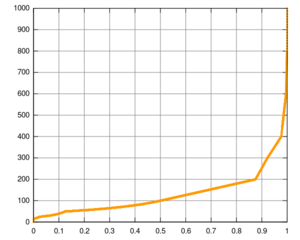Difference between revisions of "Invoke"
(I made an ash of myself) |
(→Optimum invocation schedule: Renewal Theorem; better source) |
||
| Line 7: | Line 7: | ||
Invoking strategy is basically a trade-off between the risk of getting nothing and waiting too long. The turns to wait after a successful #invoke versus probability of success are graphed below (assuming your experience is <=17): <div class="thumb tcenter">[[Image:GraphWaitingTimeVersusInvokeSuccessProbability.svg|thumb|waiting time after successful #invoke versus probability of success of invocation]]</div> | Invoking strategy is basically a trade-off between the risk of getting nothing and waiting too long. The turns to wait after a successful #invoke versus probability of success are graphed below (assuming your experience is <=17): <div class="thumb tcenter">[[Image:GraphWaitingTimeVersusInvokeSuccessProbability.svg|thumb|waiting time after successful #invoke versus probability of success of invocation]]</div> | ||
| − | Robert Schneck gives | + | Robert Schneck gives the [http://groups.google.com/group/rec.games.roguelike.nethack/browse_thread/thread/5d5a6af685f3f96d/f4bb7faac4ad5e2d?#f4bb7faac4ad5e2d optimum invocation schedule] in his [http://groups.google.com/group/rec.games.roguelike.nethack/msg/a987da11a8df6d6b ascension post of a liquid diet tourist]: |
82;81;68;81;88;67;54;96;78;62;88;81;65;63;81;65 | 82;81;68;81;88;67;54;96;78;62;88;81;65;63;81;65 | ||
| − | + | These numbers mimize the expected waiting time between successful invocations (which is the correct thing to optimize according to the [[wikipedia:Renewal_theory#The_elementary_renewal_theorem|Renewal Theorem]]). | |
== List of possible invocations == | == List of possible invocations == | ||
Revision as of 16:46, 21 July 2010
The #invoke extended command allows you to activate certain objects. The only objects that can be activated this way are crystal balls and most quest artifacts.[1]
Artifacts tire after you invoke them, and you cannot do so again for rnz(100) turns (averages 100; can be up to 2000, but 95% of the time it is less than 400). If you invoke again too soon, "You feel that the <artifact> is ignoring you" and 3d10 turns are tacked on to the wait time.[2]
Contents
Optimum invocation schedule
Invoking strategy is basically a trade-off between the risk of getting nothing and waiting too long. The turns to wait after a successful #invoke versus probability of success are graphed below (assuming your experience is <=17):
Robert Schneck gives the optimum invocation schedule in his ascension post of a liquid diet tourist:
82;81;68;81;88;67;54;96;78;62;88;81;65;63;81;65
These numbers mimize the expected waiting time between successful invocations (which is the correct thing to optimize according to the Renewal Theorem).
List of possible invocations
- The Eye of the Aethiopica: branchport to another dungeon branch.
- The Eyes of the Overworld: provides enlightenment.
- The Staff of Aesculapius: heals half HP damage, cures sickness, unblinds, unslimes.
- The Orb of Detection: toggles invisibility on/off.
- The Sceptre of Might: toggles conflict on/off.
- The Magic Mirror of Merlin: gives random rumour, from the true file if blessed, the false file if cursed, or either if uncursed.
- The Mitre of Holiness: boost in spell energy.
- The Heart of Ahriman: levitation; you can stop this levitation with '>' at will, or by invoking the Heart again, providing no other levitation sources interfere.
- The Platinum Yendorian Express Card: charges objects like a scroll of charging with the same blessed/cursed status. Only Tourists can perform blessed charging.
- The Orb of Fate: level teleport.
- The Longbow of Diana: creates 7-16 uncursed arrows if uncursed, 7-21 blessed arrows if blessed, 6-11 cursed arrows if cursed.
- The Master Key of Thievery: untraps boxes and doors with 100% success.
Invoking a non-artifact crystal ball is exactly the same as applying it.
List of possible invocations for new SLASH'EM artifacts[3]
- The Candle of Eternal Flame: summons a (tame) fire elemental.
- The Eye of the Beholder: reduces all non-undead monsters in eye's line of sight to 1/3 HP and reduces luck and alignment by 3 with luck above -9. Instadeath with luck below -9.
- The Gauntlets of Defense: toggles invisibility on/off.
- The Great Dagger of Glaurgnaa: boost in spell energy.
- The Hand of Vecna: summons 4-7 tame graveyard creatures and reduces alignment and luck by 3 with luck above -9. Does 5-24 damage to player with luck below -9.
- Holy Spear of Light: creates a lit field of a 12 square radius. This damages undead and demons in a 9 square radius.
- The Storm Whistle: summons a (tame) water elemental.
